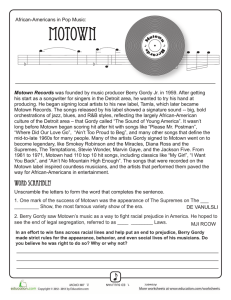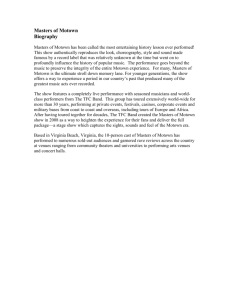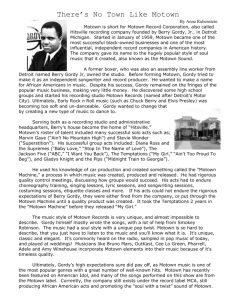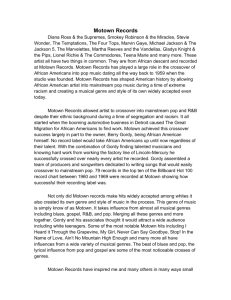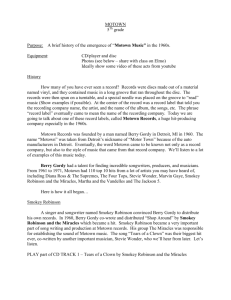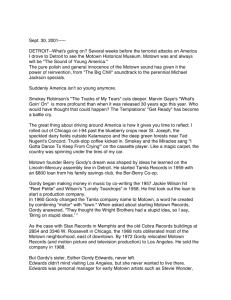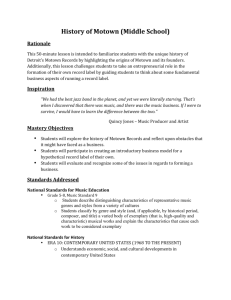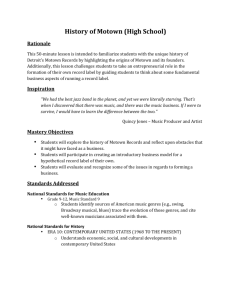motown - New York Public Library
advertisement
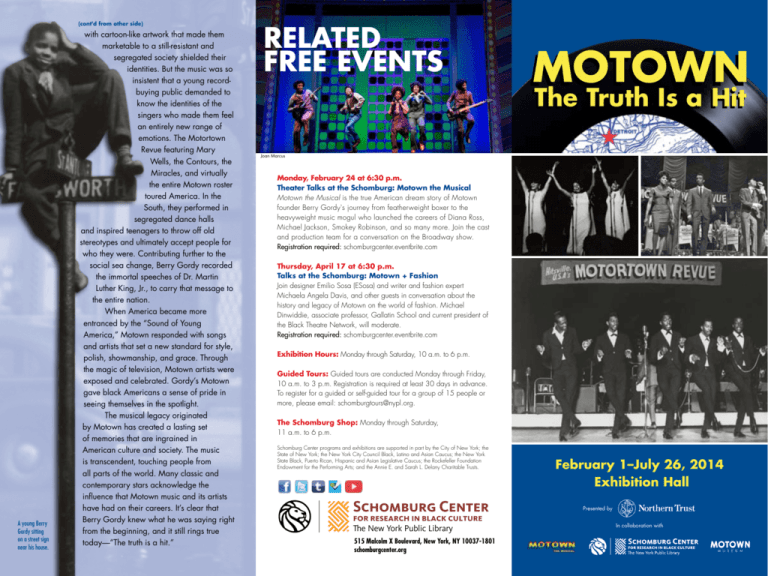
(cont'd from other side) A young Berry Gordy sitting on a street sign near his house. with cartoon-like artwork that made them marketable to a still-resistant and segregated society shielded their identities. But the music was so insistent that a young recordbuying public demanded to know the identities of the singers who made them feel an entirely new range of emotions. The Motortown Revue featuring Mary Wells, the Contours, the Miracles, and virtually the entire Motown roster toured America. In the South, they performed in segregated dance halls and inspired teenagers to throw off old stereotypes and ultimately accept people for who they were. Contributing further to the social sea change, Berry Gordy recorded the immortal speeches of Dr. Martin Luther King, Jr., to carry that message to the entire nation. When America became more entranced by the “Sound of Young America,” Motown responded with songs and artists that set a new standard for style, polish, showmanship, and grace. Through the magic of television, Motown artists were exposed and celebrated. Gordy’s Motown gave black Americans a sense of pride in seeing themselves in the spotlight. The musical legacy originated by Motown has created a lasting set of memories that are ingrained in American culture and society. The music is transcendent, touching people from all parts of the world. Many classic and contemporary stars acknowledge the influence that Motown music and its artists have had on their careers. It’s clear that Berry Gordy knew what he was saying right from the beginning, and it still rings true today—“The truth is a hit.” RELATED FREE EVENTS MOTOWN The Truth Is a Hit Joan Marcus Monday, February 24 at 6:30 p.m. Theater Talks at the Schomburg: Motown the Musical Motown the Musical is the true American dream story of Motown founder Berry Gordy's journey from featherweight boxer to the heavyweight music mogul who launched the careers of Diana Ross, Michael Jackson, Smokey Robinson, and so many more. Join the cast and production team for a conversation on the Broadway show. Registration required: schomburgcenter.eventbrite.com Thursday, April 17 at 6:30 p.m. Talks at the Schomburg: Motown + Fashion Join designer Emilio Sosa (ESosa) and writer and fashion expert Michaela Angela Davis, and other guests in conversation about the history and legacy of Motown on the world of fashion. Michael Dinwiddie, associate professor, Gallatin School and current president of the Black Theatre Network, will moderate. Registration required: schomburgcenter.eventbrite.com Exhibition Hours: Monday through Saturday, 10 a.m. to 6 p.m. Guided Tours: Guided tours are conducted Monday through Friday, 10 a.m. to 3 p.m. Registration is required at least 30 days in advance. To register for a guided or self-guided tour for a group of 15 people or more, please email: schomburgtours@nypl.org. The Schomburg Shop: Monday through Saturday, 11 a.m. to 6 p.m. Schomburg Center programs and exhibitions are supported in part by the City of New York; the State of New York; the New York City Council Black, Latino and Asian Caucus; the New York State Black, Puerto Rican, Hispanic and Asian Legislative Caucus; the Rockefeller Foundation Endowment for the Performing Arts; and the Annie E. and Sarah L. Delany Charitable Trusts. Schomburg Center for research in black culture The New York Public Library 515 Malcolm X Boulevard, New York, NY 10037-1801 schomburgcenter.org February 1–July 26, 2014 Exhibition Hall Presented by In collaboration with M otown founder Berry Gordy once said that “the truth is a hit.” And in truth, Detroit’s Motown Records became the voice of an entire generation. Starting in the 1960s, “the Motown Sound” took over the living rooms and car radios of all Americans—black and white—with its soulful pop music. But in the beginning it was Gordy’s quest for the truth that led him to create music that was universally accepted and loved. At his Hitsville U.S.A. studio, he cultivated young and emerging artists into superstars. Since long before American Idol or The Voice, the listening public has instinctively responded to the intangible emotions of honesty and authenticity. Gordy stated that “many ingredients mattered, but the trump card was always truth. If what we heard wasn’t true to the individual group or artist, or didn’t communicate a true feeling, it wasn’t going anywhere.” Our upcoming Motown exhibition, The Truth Is a Hit (presented by Northern Trust in partnership with the Schomburg Center, Motown Museum, and Motown the Musical), seeks to explore Gordy’s conception of the truth by tracing black music from its African roots through slavery, Jim Crow, the Great Migration, urban America, the Civil Rights Movement, and the antiwar movement, up to the present day. Within the larger narrative of the African-American journey, the story of the Gordy family and the evolution of Motown as a musical entity is undeniable. Motown Records transcended its origins as an entertainment vehicle and became an image-maker, a cultural icon, and a voice for freedom, justice, and equality. And in doing so, Motown and Gordy created a model for artists, entrepreneurs, and music lovers around the world. The foundation of black music begins and ends with rhythm, harmony, melody, movement, and improvisation. From the most basic tribal chant, to field work songs, spirituals, ragtime, blues, swing, bebop, doo-wop, or hip-hop, those five elements were always present. As this soulful quintet of elements journeyed across the Middle Marvin Gaye Passage, it stopped in Cuba, Jamaica, at the Apollo. (Left) Berry Gordy with Civil Rights leader Martin Luther King, Jr., actress and singer Lena Horne, and jazz musician Billy Taylor. (Top right) The Apollo Theater marquee announces an early Motortown Revue. (Bottom right) The iconic façade of Hitsville U.S.A.— the original home of Motown Records and now preserved as the Motown Museum (an historic landmark). New Orleans, and other ports of call to commune with its brethren. It settled in the fields and plantations of the southern United States and ultimately made a Great Migration with its people to the urban centers of northern U.S. cities. One such city was Detroit—and one such family was the Gordys. The first Berry Gordy was born a slave in Georgia, circa 1854. His son, also named Berry, farmed the land and became a businessman in Oconee, Georgia. He married Bertha Ida Fuller in 1922 and began raising a family that would ultimately grow to include eight children. After making a deal to sell some of his sizable acreage to a lumber company, this Berry Gordy received a large check as payment. However, cashing a check this large was problematic for a black man in 1920s Georgia. So he moved his family northward to Detroit in search of new opportunity (and also a safe place to cash and deposit that check). The Gordy family was filled with entrepreneurial spirit and established several businesses, including the Booker T. Washington grocery store, the Western Union Mutual Insurance Company, a printing company, and a home improvement contracting firm. Berry Gordy, Jr., was born on November 28, 1929, and grew up a mischievous child who idolized heavyweight champ and fellow Detroiter Joe Louis. Gordy had a series of jobs that included running his own record shop and a stint on the assembly line at a Ford and Lincoln-Mercury auto plant, and he even tried his hand at boxing. It was during these years that his passion for music began to bloom, becoming a central focus of his life. He began his musical journey as a songwriter who caught the ear of another Detroit legend, singer Jackie Wilson. It was also during this time that Gordy met lifelong friend William “Smokey” Robinson and discovered he had to become his own boss to fully realize his dream. Filled with drive and determination, in 1959 he secured an $800 loan from his family to establish what would become the largest African-American business in the world—Motown Record Corporation. Not only was Gordy a gifted songwriter and a masterful businessman, but he also had a keen sense for spotting and nurturing talent. He assembled a great team of songwriters, musicians, and singers who could capture the musical essence of the truth and transfer it emotionally. In the beginning, the world knew these artists only through their music; anonymous album covers (cont'd on flap) On the cover (clockwise from top left): The Supremes, Smokey Robinson & the Miracles, and the Temptations exhibit their dazzling showmanship, stage presence, and trademark choreography. All images, except for Motown the Musical, are courtesy of the Motown Museum.

